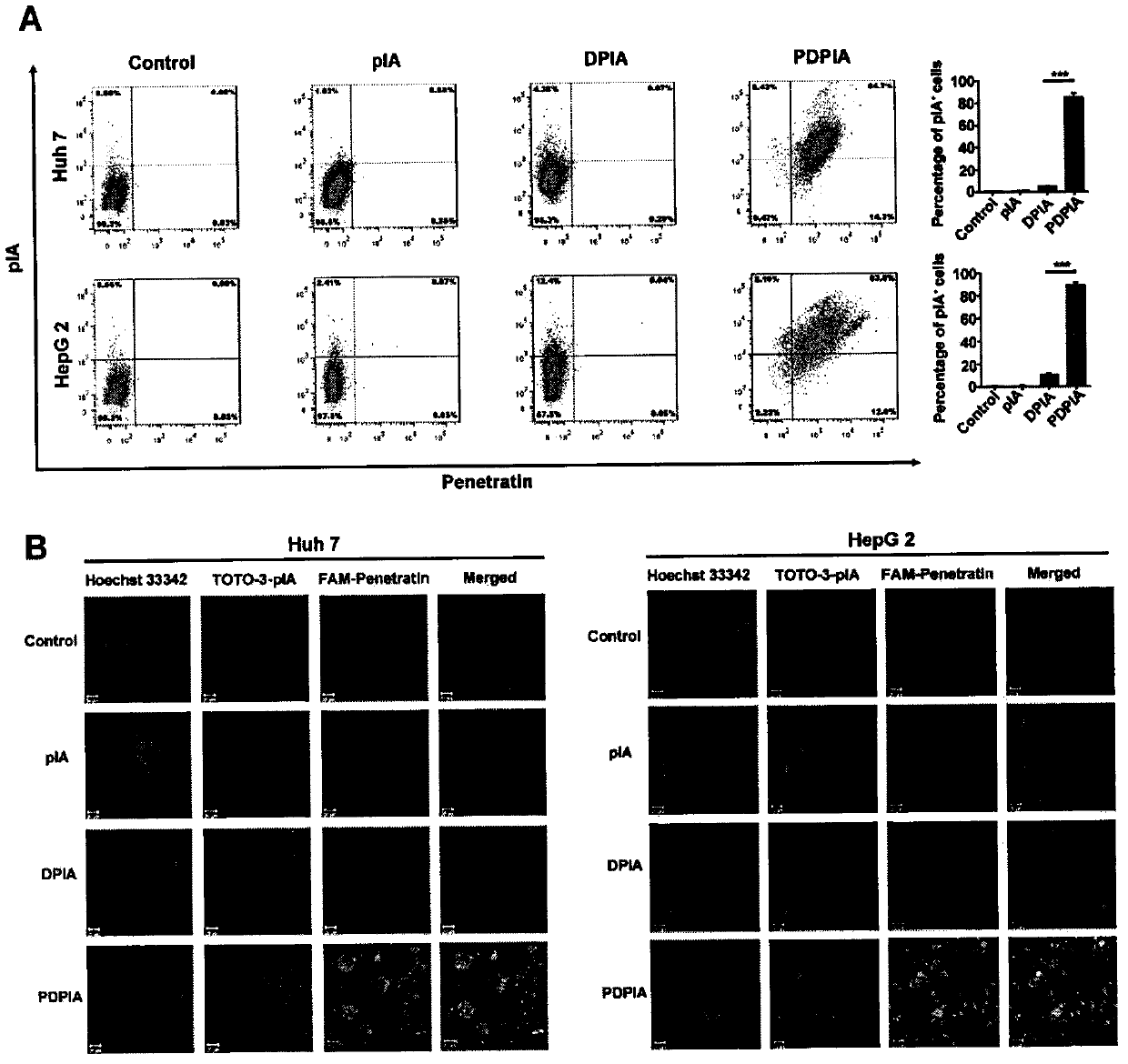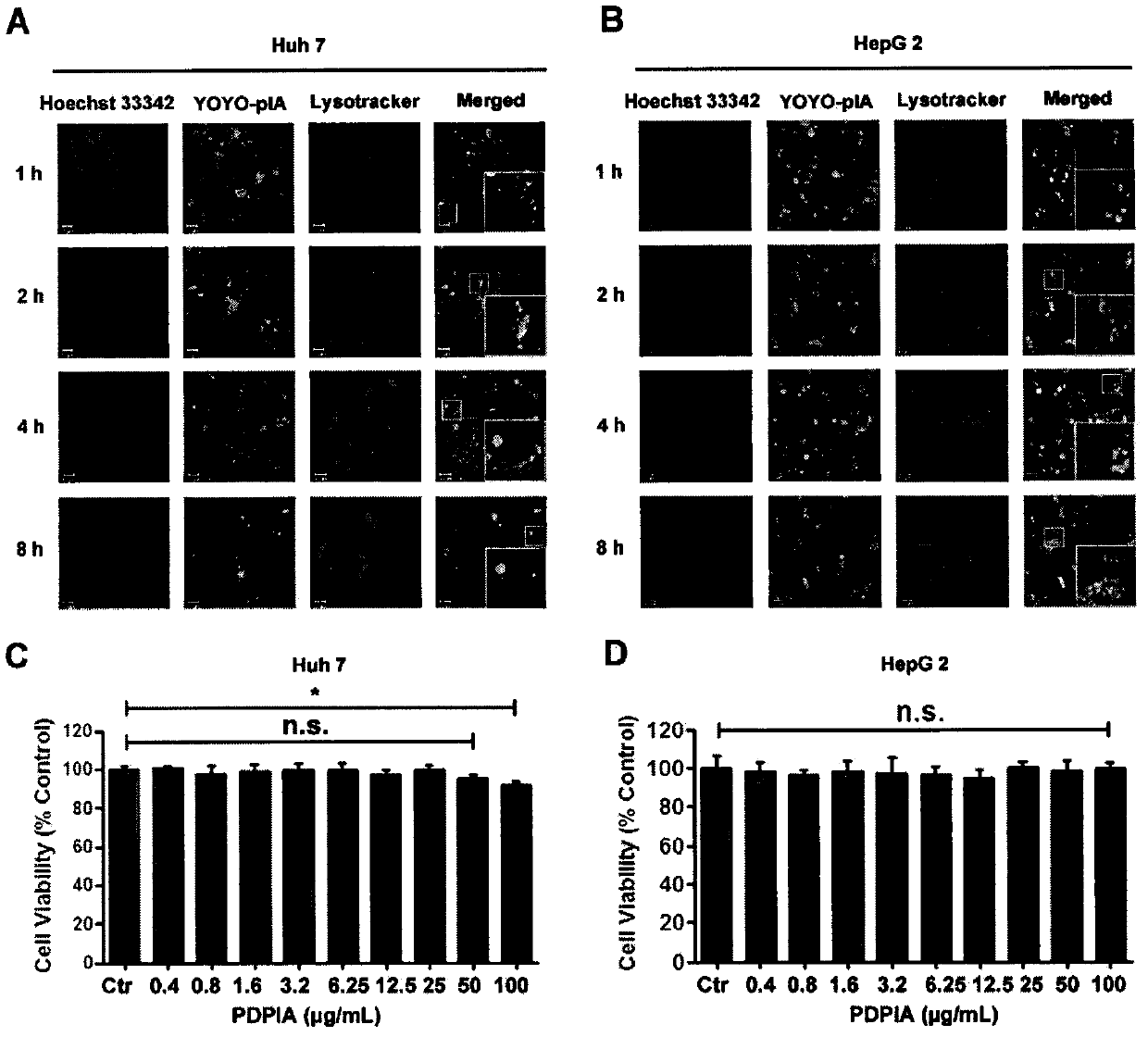Nano gene medicine for liver-related diseases as well as preparation method and application thereof
A gene medicine and nanotechnology, which is applied in the field of nanogene medicine and its preparation, can solve the problems of off-target effect monocyte-macrophage system clearance, reduce the transmembrane penetration and transfection efficiency, etc., and achieve good liver parenchymal cell targeting. Distribution effect, high penetration efficiency of hepatocyte membrane, and effect of protecting hepatocyte damage
- Summary
- Abstract
- Description
- Claims
- Application Information
AI Technical Summary
Problems solved by technology
Method used
Image
Examples
Embodiment 1
[0037]Embodiment 1, preparation and characterization of nano-gene drug (PDPIA)
[0038] First, the therapeutic gene (pIA plasmid) was dissolved in a glucose solution with a mass percentage of 5, and PAMAM3.0 cationic polymers of different mass ratios were quickly added, the mixture was vortexed for 60 seconds, and incubated at 37 degrees for one Hours, cationic polymer sephadex gel electrophoresis with different components such as figure 1 As shown in A and B, it shows that PAMAM3.0: pIA mass ratio is 2 can fully wrap the therapeutic gene;
[0039] Then, positively charged penetratingin, PAMAM3.0, and DSPE-PEG2000 were dissolved in a glucose solution with a mass percentage of 5, and the negatively charged therapeutic gene was added dropwise to the mixed solution, and the mixture was vortexed for 60 seconds. And incubate at 37 degrees for one hour, keep the ratio of PAMAM3.0: DSPE-PEG2000 at 10, adjust the mass ratio of penetratingin: pIA to form nanocomposites with different ...
Embodiment 2
[0041] Embodiment 2, the uptake experiment of hepatic cell to PDPIA
[0042] Using flow cytometry and fluorescent confocal microscopy to observe the uptake of hepatocytes to nano-gene drugs (PDPIA): first, the therapeutic gene pIA was labeled with fluorescent dye TOTO-3 and the penetratingin was labeled with FAM, and prepared by self-assembly method. Fluorescent probe-labeled nanogene drug (PDPIA), and then 1×10 5 HepG 2 cells and Huh 7 cells were seeded in a six-well plate, with the cells growing to 70%, adding fluorescently labeled pIA, DPIA, and PDPIA to the cells for 4 hours, collecting the cells with a cell scraper and washing them twice with PBS Finally, the uptake of hepatocytes to nanogene drug (PDPIA) was detected under flow cytometry, and the results showed (such as figure 2 As shown in A), the uptake rate of hepatocytes to the nano-gene drug (PDPIA) modified by penetranin and self-assembly is as high as about 80%, while the uptake rate of the nano-gene drug withou...
Embodiment 3
[0044] Example 3, PDPIA can escape the clearance of liver cell lysosomes and has a lower cytotoxicity test
[0045] Based on the fact that nanogene drugs with good lysosome escape ability have the ability to resist ribozyme decomposition, so this characteristic is the premise that nanogene drugs have excellent transfection efficiency. Literature reports point out that both phospholipidated PEG and PAMAM have Excellent lysosome escape ability, so this application speculates that the nano-gene drug composed of penetratingin, DSPE-PEG2000, PAMAM 3.0, and therapeutic gene also has excellent lysosome escape ability: this application uses YOYO dye to label PDPIA, and uses LysotrackerRed dye labeled lysosomes, observed the localization of PDPIA and lysosomes, 1×10 5 HepG 2 cells and Huh 7 cells were inoculated into culture dishes, and PDPIA was added when the cells grew to a confluence rate of 70%, and then the localization of PDPIA and lysosomes was observed at different time points...
PUM
| Property | Measurement | Unit |
|---|---|---|
| particle diameter | aaaaa | aaaaa |
| particle diameter | aaaaa | aaaaa |
Abstract
Description
Claims
Application Information
 Login to View More
Login to View More - R&D
- Intellectual Property
- Life Sciences
- Materials
- Tech Scout
- Unparalleled Data Quality
- Higher Quality Content
- 60% Fewer Hallucinations
Browse by: Latest US Patents, China's latest patents, Technical Efficacy Thesaurus, Application Domain, Technology Topic, Popular Technical Reports.
© 2025 PatSnap. All rights reserved.Legal|Privacy policy|Modern Slavery Act Transparency Statement|Sitemap|About US| Contact US: help@patsnap.com



